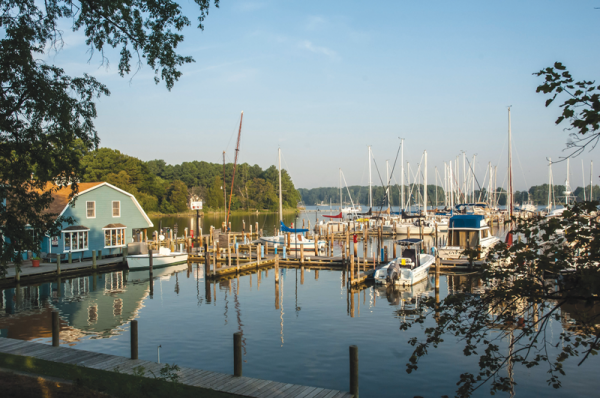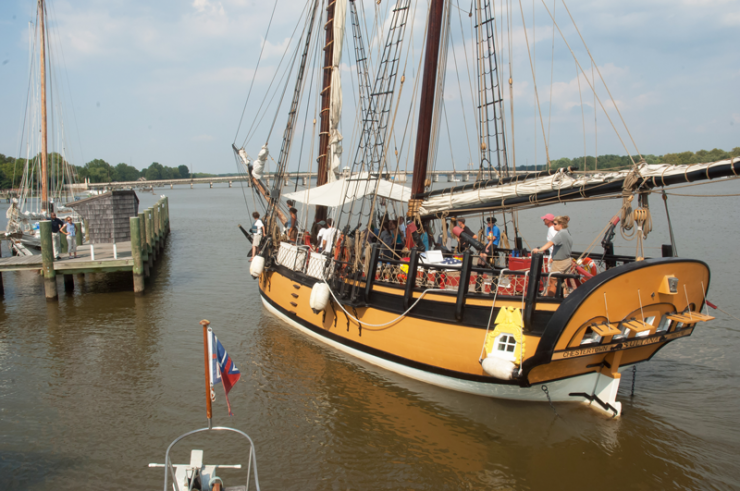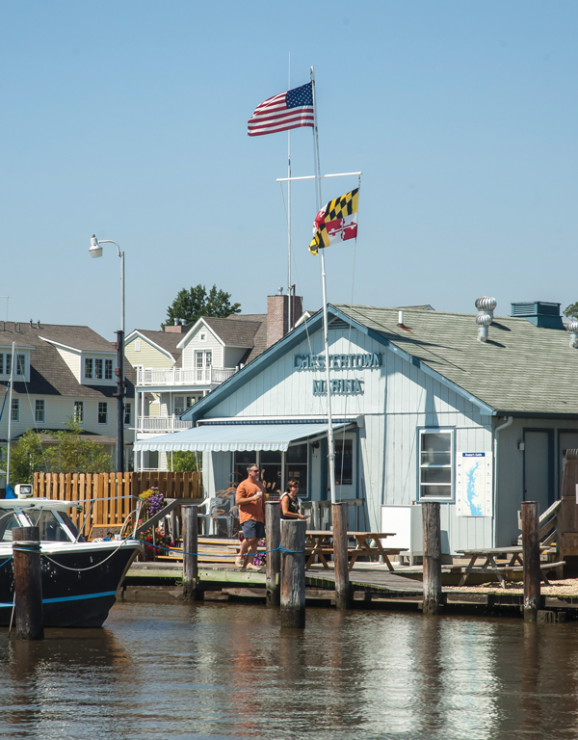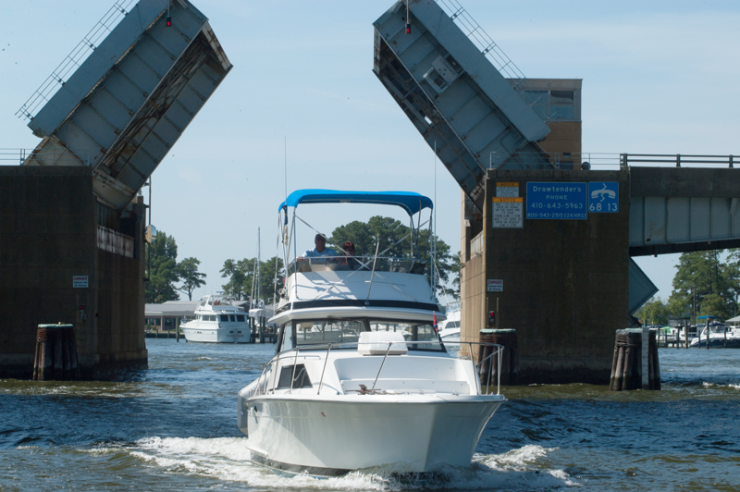Fish weirs and duck blinds and an occasional string of clam markers bobbing in the water lined the shores of the lower Chester River as we made our way at a slow six knots one sunny August afternoon. We no longer have goals when we’re cruising. We prefer general intentions, and ours were to lazily cruise up the river to Chestertown, about 30 miles from Kent Island on Maryland’s Eastern Shore. We wanted to explore and rediscover what’s in our own proverbial cruising backyard.
We left St. Michaels and had to hustle to make the bridge opening at Kent Narrows, the channel connecting Eastern Bay to the Chester River and parts north. It’s a busy thoroughfare, and we were glad the weekend traffic was just building as we jockeyed for position with some sail and muscle boats ahead of us.
The zigzag channel just north of the Bay Bridge is dicey, so we tend to look backward as much as forward to keep the boat aligned between the marks and off the shoals. Once through, we were in the mouth of the Chester River southeast of Love Point Light at the tip of Kent Island, which marks the river entrance from the Bay. We stuck our nose in the channel leading to Castle Marina just for old time’s sake because 20-odd years ago we spent several months aboard there getting to know the Bay and looking for a place to call home. We hardly recognized the marina; the covered sheds were long gone, and townhouses lined the shoreline. We turned and headed upriver to spend the night anchoring in the Corsica River passing refined waterfront homes and lush farmland.
We dropped the hook at Jacobs Nose just beyond a raftup of power cruisers. As the sun waned, we tucked behind the high shoulder of the eastern bank shaded by a wall of trees. It was late Friday afternoon, so the tubers and water skiers were out in force, getting a jump start on the weekend.
Leaving the Corsica in the morning and heading back to the Chester, we did a double-take seeing the silhouette of the square rigged Sultana, an 18th century schooner beyond in the haze. The replica was built by local volunteers in its home port of Chestertown further up the river. As a Boston-built merchant vessel, the 51-foot Sultana served as the smallest schooner ever in the British Royal Navy. Today the new Sultana offers educational programs for students of all ages; the adult crew we saw were attentively listening to an instructor and then hoisting sails.
The Chester River is a lush landscape of rolling farmlands and waterfront homes—some modest cottages, others prominent estates. What an idyllic setting. Along the way we watched a pair of osprey tangle with an eagle, squawking and carrying on like any good parent would when a predator comes too close to its nest on one of the markers. We were headed to a marina in Langford Creek, but we wanted to do a little exploring; so we took a side trip up Grays Inn Creek on the western shore of the Chester.
We found a nice anchorage in a cove opposite Herringtown Creek and a marina near the head of the creek. We pushed on, heading back to the Chester, and then turned to port to enter Langford Creek. Passing by Long Cove, we saw how the marina and boatyard there had expanded, one of the few marinas on the Bay with a lift large enough to hoist large wide power cats. We laughed, remembering it was there we saw a boat and Jeep launch simultaneously at the ramp. A fisherman pulling a John boat backed it down the ramp and got out, but the Jeep kept going until the spare tire on the roof was just above water. The quick response of the owner and a yardman got the Jeep hauled out before little damage was done, except for the pride of the chagrined fisherman.
Further up the creek we passed the Rock Hall Yacht Club and then turned to port into Langford Bay Marina on the south shore of Davis Creek. We were welcomed by the hoarse croak of two herons who appeared out of nowhere and crossed our bow. After we plugged in the power line, we went about exploring the place. From the hailing ports on the sterns of many of the boats, it appeared to be a popular spot for Pennsylvania and Delaware boaters. The marina sits in a lovely setting with nice docks and a swimming pool and gazebo overlooking the creek.
The next day, we took the short trip up the east branch of Langford Creek and ducked into Lovely Cove and understood how it got its name. As we headed back down the creek, the air was warm and hazy. Our timing was good as we headed up the river to Chestertown, because we took advantage of an incoming tide that gave us at least a half-knot boost. Most of the shoreline of the upper river was natural with seagrasses protecting against erosion, especially those leading to rolling farm fields.
The Chester twists and turns on its meandering route upriver. The river is deep almost to its shores with a few well-marked shoals, so about all the navigation required was staying in the center. Several boats lay at anchors at the wide open waters of Comegys Bight, a nice anchorage, especially for a hot airless night. The river turned one last time, and then we saw the outline of buildings marking the waterfront of Chestertown and the highway bridge beyond.
In 1706 Chestertown was a Colonial port of entry, and today it’s still welcoming seafarers, on cruising boats now, instead of sailing vessels. The historic homes are a lasting testament to the town’s prosperous heritage as a thriving shipbuilding and trading center. A row of Colonial homes lines the river, and the trees along the streets shade neighborhoods with a unique mix of restored Georgian, Federal, and Victorian homes. George Washington really did sleep there. Washington College, his namesake, is a central part of the culture and community life.
We stayed at the Chestertown Marina at the foot of town and took an after-dinner stroll passing the old railroad station that made Chestertown a transportation hub of the large farming community surrounding the area. We walked by the boatyard where Sultana was built and saw the nightly ritual of locals feeding a gaggle of hungry geese and ducks trying to get their fair share at the waterfront park. Overnight a wind shift from the north brought cooler temperatures and especially nice sleeping conditions, with hatches open and just-cool-enough breezes. In the morning, we went to Play It Again Sam’s, a funky eatery. The place is clearly the local’s favorite where retirees sit around a big farm table reading the paper and chatting; worker-bees came in for their morning caffeine infusion.
It was our fourth day out, and we waited for the outgoing tide to help carry us down the river where we saw new vistas we had missed earlier. Binoculars gave us a closer look at the shoreline to see brackish Bay marshes sprouting tall cattails with loblolly pines in the background. We watched as gulls hovered over the water and then plunged feet first for fish below the water surface. We realized that although we had no intention of going down memory lane on this cruise, seeing people and places sparked memories of why we moved to the Bay: to enjoy the abundance of nearby places to cruise.
We anchored at Queenstown Creek not far from the Kent Narrows Channel and opposite the Eastern Neck National Wildlife Refuge. We followed the long direct channel off the river, but just before entering Queenstown Creek, the channel takes you through a shallow bar; it’s very narrow, so we favored the green side and found six feet or more. Once inside, the depth fell off to 10 feet or so. Inside we turned to port into the north fork of the creek around the sandy shoreline of Blakeford Point into a nice protected cove and dropped the hook. South of the Point was Little Queenstown Creek which led to the town harbor.
We took a dinghy ride to the town dock to see the sleepy little hamlet just a few blocks from the harbor. You can’t miss the town dock since the fireboat is moored there. An Historic Queenstown banner greeted us as we walked up Second Street and saw a charming house surrounded by a white picket fence with a sign that read “Dockmaster.” We turned on Charity Street and were soon on Main Street with a post office, bank, café, and a few small shops. The quiet neighborhood of well-kept cottages had no sidewalks, and was a stark contrast with the suburban housing surrounding the area. We marveled at how a treasure like this, so close to the Bay Bridge, has retained its rural character. It was a quick ride back to our slip at the Miles River Yacht Club when we realized we had logged only 75 miles from start to finish, reaffirming our notion that you don’t have to go too far from your home waters to really get away.
By Katie and Gene Hamilton (Originally published in September, 2016)



